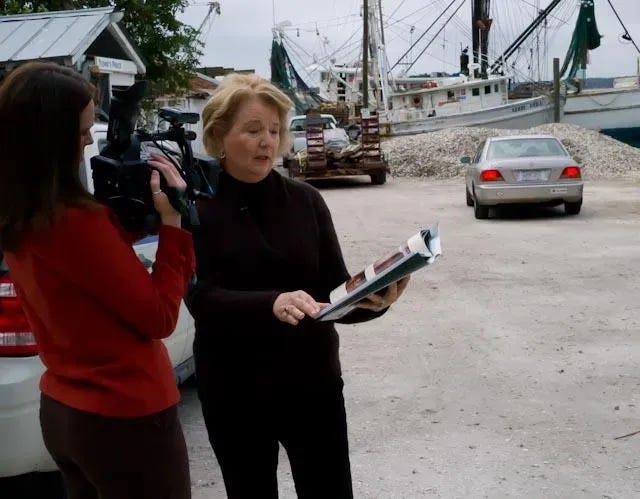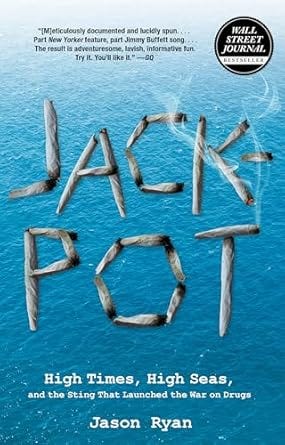Operation Jackpot
HIgh Times, High Seas and the Sting that launched the War on Drugs
Dark secrets lurk beneath the tidal, brackish waters of Beaufort County. The evil deeds I’m about to write go back to the 1970s and early ‘80s when drug smugglers made their midnight runs up secret channels with luxury sailboats and speed boats full of marijuana.
Writing about this place and time, taking you back to days of mystery and crimes long forgotten will never be easy. I prefer telling you tales of humor, Southern life, our unique culture, history, and adventures. But this story, too, is part of our history. Although the crimes I’m about to tell you occurred decades ago, not much was ever written about the lives that were threatened by the perpetrators who committed the crimes. It remains a black cloud over what became a dark hour in South Carolina history.
This story is personal - my husband was a land developer and we owned 6 miles along the intercoastal waterway with many good places where they could secretly offload. Landowners who did not cooperate could easily end up in the bowels of a ship’s hold - or worse.
During this time developers who owned land along these endless waterways were fair game for the smugglers who would do anything to protect themselves and gain access to places where they could offload in secret. Having an accessible and secluded place to offload was vital to their success.
Our land was surrounded by islands, dense marshlands, and thick vegetation. This undeveloped seclusion was exactly what they were looking for. Cramer’s Island at the far end of our property was perfect. They offered millions with the only stipulation being that we must be far away during their offloading operation. We denied all offers and were left at the mercy of a bunch of lawless scoundrels. Many sleepless nights followed - I held my loved ones tighter not knowing what the next day would bring.
.
What to do
First, we sought counsel from a local prominent attorney. His office was in historic downtown Beaufort in a well-maintained home built in the early 1800s. Upon our arrival an attractive young woman ushered us in where we were seated in plush leather chairs, surrounded by what looked like endless acres of leather-bound law books. While my husband was seeking advice and telling his story, the lawyer interrupted him, leaned back in his chair, and said in his slow southern draw, “Why folks in South Carolina are known to be killed over a lot less money than what they’re offering. You’re on your own, son. Not for me to be involved.”
How we tried to protect ourselves
Our land had an existing golf course that had been built by the former owners. It was through many rounds of golf that my husband developed a lasting true friendship with Dennis Marsh, the head of the local FBI. Dennis had a few of his men stake out on the islands and deep channels to watch for any activity. Local law enforcement got involved and spent nights parked close to the tidal marsh by the side of our house. Smugglers often made midnight runs. We lived on the waterway giving easy access to anyone wanting to do harm. Fortunately, when they got wind of the presence of police it caused them to scatter. I later learned of an incident in 1976 down in the Florida Keys where the approach of police caused smugglers to flee, sending a 65-foot sport fishing yacht with 15,000 pounds of marijuana on autopilot toward Cuba, “never to be seen again.”
After what felt like an endless amount of time, they left us alone knowing of the risk, and sought other plantations along the coast owned by wealthy Northerners who rarely visited. McClellanville’s creeks became popular, too. Other choices later included an abandoned oyster shelling company on Hilton Head and West Bank Plantation on Edisto Island. They grew their network to include names like Tom “Rolex” Rhoad, John “Smokin’ Sneakers” Jamison, and “Willie the Whale” Bauer.
For the most part, these men eschewed violence as much as they loved pleasure, but no one knew what they might be capable of doing until much later. The investigation and prosecution is known as Operation Jackpot, which is chronicled in the book, Jackpot: High Times, High Seas, and the Sting that Launched the War on Drugs, by Jason Ryan, a reporter for the Beaufort Gazette.
During Beaufort County’s golden age of marijuana trafficking, the country’s most prominent kingpins were a cadre of wayward and fun-loving Southern gentlemen who forsook college educations to sail drug-laden luxury sailboats across the Mediterranean, the Atlantic, and the Caribbean. These irrepressible adventurers unloaded nearly a billion dollars worth of marijuana and hashish through the eastern seaboard's marshes. The kingpins were Columbia natives Les Riley and Barry Foy nicknamed “the Gentlemen Smugglers” given their standards and college education. “ We laundered a lot of money,” said Foy during an interview with the Island Packet. “Millions. Plural. Tens of millions.” For the kingpins that meant parties, women, Lear jets, luxury cars, yachts, and oceanfront homes. Others could get $10,000 for serving as a lookout or a decoy, up to $50,000 to help unload a boat, and $250,00 for lending out a trawler for a night. A boat captain could earn $400,000.
Other smugglers showed up on Hilton Head with an army of local recruits, and boats full of drugs and were soon sneaking through the tides of the South Carolina coastline that had protected rum-runners and pirates of long ago. They delivered loads of marijuana to McClellanville, Edisto, St. Helena, Dataw, and Pine Islands.
Barry Foy and Les were making so much money it was hard to figure out what to do with it all.
Foy had an oceanfront home at the end of Mallard Road in North Forest Beach. “We partied every night,” he said in an interview. “How could you not.” They stored their money in safe havens around the world but also spent it on homes, cars, and exotic vacations. While both men delegated sailing and offloading to others, they enjoyed the thrill of smuggling and the lifestyle it afforded them. They began importing hashish from faraway locales like Lebanon and Singapore. A normal hashish load had a street value of 90 million dollars.
The major drug smuggling ring stretched from 1973 to 1983 and the men involved lived the epitome of an overindulgent lifestyle. One smuggler took a date aboard the Concorde jet to Paris for dinner, then jetted back home that same night, just because he could. Ironically the money that drove the show ended up killing it. With so much money, it was tougher to keep everyone happy. And just think of the logistical challenges. Some of the smugglers had closets full of cash. How could they keep from creating paper trails when investing so much of it and the temptation of buying everything they wanted?
In January 1981, Ronald Reagan became president and began a stiff policy on drugs. One of his earliest actions, on the recommendation of Sen. Strom Thurmond, was to appoint Henry McMaster as South Carolina’s United States attorney. He immediately sought to attack drug smuggling at the highest levels of the trade. He joined together the FBI, the Drug Enforcement Agency, United States Customs, and the IRS into a task force along with SLED. This was unprecedented for these agencies to share information and work together out of one office. But by coming together with their collective expertise, they were an effective weapon against drug smuggling. This task force, along with the U.S. Attorney’s Office worked to bring the Gentlemen Smugglers and their associates to justice.
Barry Foy was apprehended at the La Guardia airport wearing a full-length mink coat. Les and another defendant, Wally Butler, were found living in Australia and arrested in May of 1983. I knew Wally, who had been a real estate agent working in Sea Pines and a neighbor who lived nearby on Calibogue Sound. As it turns out, his property was a good place to bring in drugs. His genteel demeanor never led me to suspect he could be involved in drug smuggling. The investigations, asset seizures, defendant arrests, and trials were full of extraordinary stories and consumed the lives of task force members for years. When the Operation Jackpot trials were over, more than 200 smugglers went to jail, charged with smuggling, racketeering, tax evasion, conspiracy, and relatively tame charges compared with the violence surrounding contemporary drug trafficking.
Henry McMaster ascended to South Carolina’s governorship in 2017 and was elected to his first full term in November 2018.
In the fall of 1986, President Reagan declared, “Operation Jackpot was our first major breakthrough in our war on drugs.” Years later, they are now all out of prison, some have passed away and some have productive lives and are living well. In fact, the surviving Gentlemen Smugglers used to gather at an event they called, “The Felon’s Ball.”
“Final Load” is now a movie about Operation Jackpot
Over thirty years have passed since this major drug investigation led to 200 people being charged in the Lowcountry. Even after prison, Lowcountry drug smugglers say, ‘ We weren’t doing anything wrong.’ They believed it, never understanding the collateral damage and lives that changed forever.
Beaufort County is the backdrop of the film which is loosely based on the legendary drug smuggling exploits of the “gentlemen smugglers” who helped launch the career of a young U.S. attorney who would later become South Carolina’s governor.
“Final Load”, filmed at locations across the Lowcountry including Beaufort and St. Helena Island was created by businessman Walter Czura, who made the movie with his production company, Fortress Films.
Information for this story is credited to the book by Jason Ryan, “Jackpot”, the Island Packet, The Columbia Metropolitan Magazine, the Island News and UPI Archives.




A huge thank you to everyone who wrote and commented. It's a story long forgotten by most but still significant. Landowners had a difficult dealing with the drug dealers and their demands. There are more stories about those who accepted the deal and ended up in dire circumstances. It's not a game for the faint of heart.